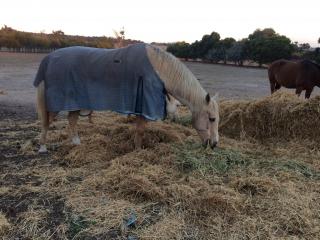The Department of Primary Industries and Regional Development is reminding livestock producers, including horse owners, of the importance of testing hay for annual ryegrass toxicity (ARGT).
Department veterinary officer Anna Erickson said because annual ryegrass was often present in oaten and meadow hay, there was also a risk that ARGT could be present.
“ARGT is a serious and usually fatal disease that occurs when livestock eat annual ryegrass seedheads that are infected with a toxin-producing bacterium,” Dr Erickson said.
“ARGT is most often seen in spring when livestock graze pastures containing infected ryegrass seedheads, but the risk for ARGT remains when that pasture is turned into hay. Drying the grasses for hay does not eliminate the toxin.
“It is recommended that stock owners and feed sellers have hay containing annual ryegrass tested for the presence of the bacterium that causes ARGT before they feed it to stock.
“Whenever producers buy hay, they should obtain a commodity vendor declaration (available on the Meat and Livestock Australia website) that states that the feed has been tested for ARGT and is classified as ‘low risk’. Horse owners buying hay from feed stores or a private supplier should ask to see a copy of a testing certificate.
“Owners should also note that while feed testing reduces the risk of ARGT poisoning, it does not eliminate it, as ARGT could be present in other untested parts of the bales.”
Dr Erickson said that signs of ARGT in livestock included trembling, clumsy gait, jaw champing, difficulty swallowing and drinking, and dullness, followed by lying down and convulsions.
“The toxin accumulates slowly, so stock may not start to show signs of the disease until they have had several weeks on the same hay source,” she said.
“Signs are made worse by stress or movement, and apparently normal animals may suddenly show severe signs (collapse, seizures, and death) when disturbed. Animals showing these signs should be slowly moved to a quiet area and disturbed as little as possible until veterinary advice has been sought.”
Dr Erickson said the signs of ARGT were similar to some reportable diseases not present in Australia.
“Producers are encouraged to have a private or department vet take samples to submit for laboratory testing for animals with these signs so that we can rule out any reportable diseases,” she said.
“Data from this testing helps to protect WA’s livestock industries, as trading partners ask us to provide proof that Australia is free of these diseases. Where a number of animals are affected with these clinical signs, producers may qualify for the Significant Disease Investigation Program. Ask your private vet or department vet for details.”
More information on ARGT and hay testing can be found on the department website.
Media contacts: Jodie Thomson/Lisa Bertram, media liaison +61 (0)8 9368 3937

